Science Highlights, April 13, 2016
Awards and Recognition
Capability Enhancement
Asterix neutron spectrometer probes chemical evolution of surfaces
Proton Radiography Facility commissions electromagnetic magnifier
Earth and Environmental Sciences
Water signatures and their thermal stability in bedded salt for nuclear waste storage
Materials Science and Technology
Largest ever temperature range achieved while measuring TATB crystal structure
Awards and Recognition
Roger Wiens awarded French knighthood
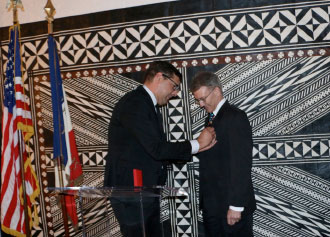
Roger Wiens (right), leader of Los Alamos National Laboratory’s ChemCam project, received the honorary title of knight in France’s Academic Order of Palms. Christophe Lemoine (left), Consul General of France, presented him with the insignia. Photo courtesy of the Consulate General of France
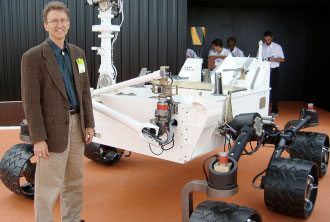
Roger Wiens and the Mars Curiosity rover.
France’s Academic Order of Palms recognized space scientist Roger Wiens (Space and Remote Sensing, ISR-2) with the honorary title of chevalier (knight) for his work in forging strong ties between the French and American scientific communities. Wiens is the principal investigator of the ChemCam, a laser spectroscopy instrument on NASA’s Mars Curiosity rover that was developed at Los Alamos National Laboratory in collaboration with French scientists.
“The contributions you have made to spectroscopy and space exploration throughout your lifelong career in research are tremendous,” said Christophe Lemoine, Consul General of France, during his remarks at a ceremony in Los Angeles, California. “Your work has touched the lives of many young, ambitious earthlings who aspire to follow in your footsteps.”
Wiens leads a team responsible for the ChemCam laser instrument on board the Curiosity rover, which has been exploring Mars since 2012. ChemCam analyzes the planet’s composition using a laser that vaporizes rocks and soil for chemical analysis. Wiens also directs a joint effort between Los Alamos and a team at the French space agency, Centre National d’Etudes Spatiales, to develop SuperCam, the next-generation version of the ChemCam device. NASA selected SuperCam in August 2014 to be part of the new Mars 2020 rover payload. The Laboratory has a long, storied history in space sciences as part of its national security mission and commitment to innovate science and technology.
The palmes académiques is the oldest non-military French decoration, established by Napoleon I in 1808. As an American, Wiens is one of only few hundred non-French citizens to be recognized with this distinction. Technical contact: Roger Wiens
Marc Janoschek selected for Hans Fischer Fellowship

Marc Janoschek
Marc Janoschek (Condensed Matter and Magnet Science, MPA-CMMS), has been chosen for a Hans Fischer Fellowship at the Technical University of Munich (TUM) Institute for Advanced Study in Germany. The three-year fellowship is named for TUM professor Hans Fischer, who received the 1930 Nobel Prize in Chemistry. Janoschek will conduct research to improve the understanding of complex material properties that emerge in quantum matter at the extremes of high pressure.
The fellowship enables exceptional early-career international scientists to explore cutting-edge, high-risk topics in their scientific research areas in partnership with a TUM research group.
Janoschek and TUM collaborator Christian Pfleiderer will use novel state-of-the art neutron-resonance spin-echo (NRSE) spectroscopy techniques at the Munich research reactor that provide unprecedented energy resolution. They will examine the emergent properties of quantum matter. Janoschek’s fellowship research, outlined in his proposal, “New Frontiers of Neutron Spectroscopy in Quantum Matter” aligns with the research he conducts within the program “Complex Electron Materials” that is funded by DOE’s Office of Basic Energy Sciences and with the grand challenges outlined by DOE and the Lab’s Materials for the Future science pillar.
Janoschek performed his doctoral studies in solid-state physics at the Paul Scherrer Institut in Switzerland and at TUM, where he graduated summa cum laude. He was a Feodor-Lynen postdoctoral fellow of the German Alexander von Humboldt Foundation at the University of California – San Diego, in the group of Brian Maple. Janoschek has been the capability leader for neutron scattering in MPA-CMMS since 2011. He has received the Wolfram-Prandl Prize for his innovative neutron scattering experiments on the microscopic magnetic interactions that determine the functional properties of helical magnets. Technical contact: Marc Janoschek
Jaroslaw Majewski named Fellow of the Neutron Scattering Society of America

Jaroslaw Majewski
The Neutron Scattering Society of America (NSSA) has honored Jaroslaw (Jarek) Majewski of the Center for Integrated Nanotechnologies (MPA-CINT) with the title of Fellow. The NSSA Fellowship Program recognizes members who have made significant contributions to the neutron scattering community in North America through original research and publication, innovative applications of neutron scattering, contributions to the promotion or development of neutron scattering, or participation in the activities of the NSSA or neutron community. The Society recognized Majewski “for contributions to our understanding of weakly organized two-dimensional systems, including surfactant molecules found in biological systems.”
Majewski received a PhD in Materials and Interfaces from the Weizmann Institute of Science in Israel. He performed research at HASYLAB in Germany, the Advanced Photon Source at Argonne National Laboratory, Risø National Laboratory in Denmark, National Institute of Standards and Technology, and Oak Ridge National Laboratory. He joined Los Alamos as a Director’s Funded Postdoctoral Fellow and became a staff member in 1997. Majewski performs x-ray and neutron scattering studies of thin films and interfaces to examine their structural properties and interactions. He conducts experiments at the Lujan Neutron Scattering Center at the Los Alamos Neutron Science Center (LANSCE) and the Center for Integrated Nanotechnology (CINT). Majewski also serves as an adjunct professor at the Department of Chemical Engineering at University of California – Davis.
The American Physical Society named him as Fellow for his contributions to understanding the structural properties of Langmuir films and model biomembranes at solid-liquid interfaces using x-ray and neutron scattering. Majewski has received a NNSA Defense Program Award of Excellence and a Los Alamos Director’s Individual Distinguished Performance Award.
The Neutron Scattering Society of America (NSSA) was formed in 1992 and organizes members from more than 26 countries with interest in neutron scattering research in a wide spectrum of disciplines. No more than one-half of one percent of members are honored as fellows through election by the Fellowship Committee. Technical contact: Jaroslaw Majewski
Tom Terwilliger elected 2016 President of the American Crystallographic Association
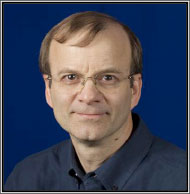
Tom Terwilliger
The American Crystallographic Association (ACA) has elected Tom Terwilliger of Biosecurity and Public Health (B-10) to be the 2016 President of the ACA. The ACA is a scientific organization of over 2,200 members in more than 60 countries who use x-rays, neutrons, and electrons to determine the structure of molecules at atomic (or near atomic) resolution. Terwilliger was elected vice-president of the ACA in 2015 and will serve as president in 2016 and past-president in 2017.
Terwilliger obtained a PhD at the University of California – Los Angeles. He was a Helen Hay Whitney Postdoctoral Fellow and a Presidential Young Investigator before joining Los Alamos in 1991. Terwilliger was one of the founders of the field of structural genomics, in which the three-dimensional shapes of large numbers of proteins are determined in order to provide a foundation for understanding biology. He also founded the TB Structural Genomics Consortium to determine shapes of proteins from tuberculosis bacteria and provide a basis for drug discovery for treatment of the disease. Terwilliger is part of a multidisciplinary team focused on understanding how bacteria can pump antibiotics out of the cell and prevent the antibiotics from working.
Terwilliger received the ACA’s Trueblood Award for development of the SOLVE/RESOLVE software, the world’s first completely automated procedure to determine the shapes of proteins by analyzing the diffraction of x-rays from protein crystals. SOLVE won an R&D 100 Award. The latest evolution in this technology, PHENIX (Python-based Hierarchical ENvironment for Integrated Xtallography), is a software suite that expands the capabilities of SOLVE/RESOLVE. He is a Fellow of the ACA, the American Association for the Advancement of Science, and Los Alamos National Laboratory. Technical contact: Tom Terwilliger
Capability Enhancement
Asterix neutron spectrometer probes chemical evolution of surfaces

The completed modifications (a new detector gantry and sample positioning mechanism) enable vertical scattering geometry.
Modification of the Lujan Neutron Scattering Center’s polarized neutron reflectometer, Asterix, has created new experimental capabilities. This will enable comprehensive characterization of chemical and structural properties of the surfaces of materials and experimental environments to control the hydration, oxidation, temperature, and pressure for a wide range of conditions. The instrument’s conversion into a versatile nano- and meso-scale neutron scattering beamline permits measurements in horizontal and vertical surface scattering geometries. For example, its horizontal sample geometry allows handling heavy and bulky sample environments required to study thin layers and bulk material surfaces in extreme environments. This capability could be applied to study low-rate kinetics, such as occurs in surface oxidation or evolution in a corrosive environment.
Surfaces and interfaces play a major role in material properties and frequently determine the behavior of bulk materials and their aging. They are especially important in determining the behavior of soft- and condensed matter nanostructured materials, such as metallic surfaces, polymer composites, multilayer structures, and bio-related systems. Experimentally investigating interfaces presents significant challenges. Because interfaces are often buried within the material, accessing them requires destructive characterization or extensive sample preparation methods, such as for transmission electron microscopy or atom probe tomography. Despite many recent developments, interface structure and properties remain poorly understood, in part due to a limited experimental toolbox for their characterization.
Neutron scattering offers unique opportunities for studying interfaces due to the high penetration depth of neutrons and the non-monotonic dependence of their scattering cross-sections on atomic numbers. For example, interfaces in metals typically have low thickness and may be atomically sharp. Therefore, investigation of interfacial phenomena requires high – sometimes ångstrom-level – spatial resolution. Moreover, certain interfaces only exist at high temperatures and pressures or under contact with external media, such as gases or liquids. Investigating such interfaces requires special techniques and in situ characterization methods, which are at the core of MaRIE, the Laboratory’s proposed experimental facility for the study of Matter-Radiation Interactions in Extremes.
In surface sensitive scattering methods, a neutron beam strikes a flat sample at a small angle of incidence (or a particular value of the momentum transfer vector, Q) and can undergo reflection, transmission, or refraction at various interfaces within the sample. Consequently, the intensity of the outgoing, scattered neutron beam differs from that of the incident beam. This difference –measured as a function of Q – encodes information about the physical structure and composition of the surface or interfaces.
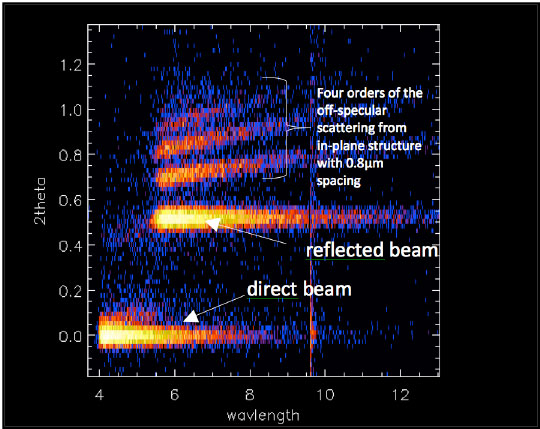
Figure 1. Off-specular scattering measured on Asterix shows possibilities to address the in-plane structures with approximately μm spacings. In this case, the scattering originated from linear groves with 0.8 μm spacing.
The new modification also enables investigation of “off-specular” scattering from the samples. Off-specular data provide the neutron intensity distribution as a function of the neutron momentum transfer vector parallel to the sample’s surface. This information can provide additional insight into in-plane correlations of the surface and interface structures. For example, such data can address correlations between the roughness of different interfaces, corrosion-induced pitting processes, and the growth or phase separation of in-plane islands.
Mechanical and data reduction modification and upgrades are complete and Asterix has been commissioned. The Lab plans to install small angle scattering (SANS) and grazing incidence small angle scattering (GISANS) capabilities in the future. With that completed, Asterix will be one of the most versatile neutron surface scattering spectrometers in the DOE complex, allowing a wide range of scattering – from material surfaces and bulk materials – to be performed.
Erik Watkins (Materials Synthesis and Integrated Devices, MPA-11), Jarek Majewski (Center for Integrated Nanotechnologies, MPA-CINT), and Mark Taylor (Engineering Services for LANSCE Facility Operations, ES-LFO) performed the Asterix upgrade. The capability supports the Laboratory’s Nuclear Deterrence mission area and the Materials for the Future and the Nuclear and Particle Futures science pillars by providing mesoscale details about weapon materials. The measurements from Asterix will support work funded by the NNSA Science Campaigns. The work is an example of science on the roadmap to MaRIE, the Laboratory’s proposed experimental facility for Matter-Radiation Interactions in Extremes. Technical contacts: Erik Watkins and Jarek Majewski
Proton Radiography Facility commissions electromagnetic magnifier
A new set of magnets at the Proton Radiography Facility (pRad) at Los Alamos Neutron Science Center (LANSCE) has improved the reliability and predictability of this important capability for imaging dynamic experiments in support of weapons science and stockpile stewardship programs.
Invented at Los Alamos National Laboratory, proton radiography uses a high-energy proton beam from the LANSCE accelerator to image the properties and behavior of materials under a variety of conditions. The penetrating power of high-energy protons makes them an excellent probe of a wide range of materials under extreme pressures, strains, and strain rates. The pRad capability has revolutionized dynamic materials science at the Laboratory, providing a new window for the study of shock physics, materials damage, and high explosives science.
The team replaced the permanent magnet quadrupoles (PMQ), which can demagnetize due to radiation damage. Even with the Lab’s in-house re-magnetization capabilities, this was a serious limitation, especially for experiments that require high beam doses such as the series of “solidification” experiments and tomography of static object. The new EX3 magnifier consists of four quadrupole magnets, four power supplies, mounting structure, and water cooling. Figure 2 depicts the layout. Beam line simulations indicate that the short quadrupoles Q1 and Q4 can, in principle, be connected to one power supply in series (ISQ); the same applies for the long quadrupoles Q2 and Q3 (ILQ). For the first pass tests, the researchers connected each magnet to its own power supply to provide additional flexibility in tuning the system.
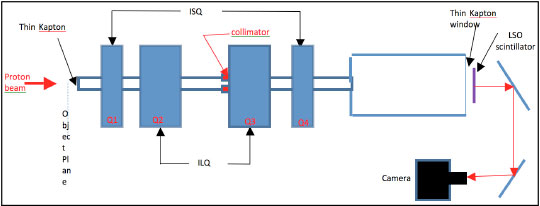
Figure 2. Schematic diagram of the pRad beam line setup. Two types of cameras with different pixel resolution acquire data. An image plate at the lutetium oxyorthosilicate (LSO) scintillator position acquires a high-resolution image.
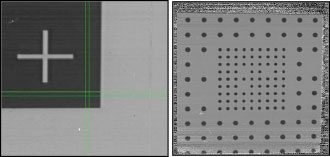
Figure 3. (Left): Image of a corner of the tungsten resolution plate. The cross is a 0.5 mm cutout and is 6 mm by 6 mm. (Right): Image of a fiducial plate. The black circles are small disks of tungsten imbedded in a plastic substrate. The spacing in the inner cluster is 2.5 mm; the outer ones are 5 mm apart. The image shows that the field of view of the imaging system is about 4 cm by 4 cm.
Images of standard pRad tuning objects determined rough focus quadrupole settings for the new system. For example, a 3-mm-thick tungsten resolution plate measured system edge resolution [Figure 3 (left)] Other tests confirmed the presence of a small rotational misalignment, which the team corrected. The researchers performed a final focus scan by changing the magnet currents according to a method that they had developed using beam-optic simulations.
During the current shutdown period, the team will complete permanent installation of the EX3 in the pRad dome. Based on lessons learned during the commissioning phase, they will modify existing subcomponents and incorporate new hardware – such as more precise magnet current monitoring instrumentation. The team will require about three days of beam early in the next run cycle to check the system once more before formally declaring it ready for dynamic experiments.
The following people contributed to the success of the project: John Goett II, Frank Merrill, Paul Nedrow, Josh Tybo, and Carl Wilde (Neutron Science and Technology, P-23); Matt Freeman, Brian Hollander, Julian Lopez, Fesseha Mariam, Michael Martinez, Jason Medina, Patrick Medina, Chris Morris, Debbie Morley, Matthew Murray, Levi Neukirch, Andy Saunders, Thomas Sisneros, Amy Tainter, Frans Trouw, and Dale Tupa (Subatomic Physics, P-25); Eric Larson (LANSCE Weapons Physics, P-27); James O’Hara and team (Mechanical Design Engineering, AOT-MDE); David Barlow, Joe Bradley, and team (Radio Frequency Engineering, AOT-RFE). Institutional PADSTE G&A Science Investment funded the work, which supports the Lab’s Nuclear Deterrence mission area and the Materials for the Future and Science of Signatures science pillars. Technical contact: Fesseha G. Mariam
Chemistry
Mechanism of one of the most efficient artificial catalytic reactions
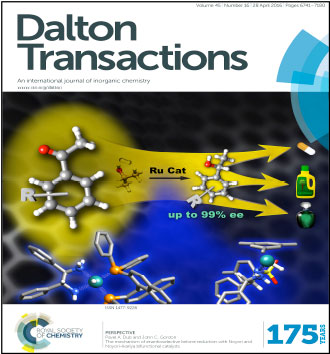
Figure 4. Artist’s concept of the conversion of starting material to a wide range of products. ee is enantiomeric excess. Image credit: Josh Smith (Chemistry Division, C-DO)

Figure 5. Structure of the industrially important Noyori catalyst. Ru is ruthenium, H is hydrogen, N is nitrogen, P is phosphorus, Cl is chlorine, and Ar is aryl.
Catalytic hydrogenations represent the largest-volume human-made chemical reactions in the world. Many industrially important processes are based on a homogeneous version of this reaction. Homogeneous catalysis provides convenient properties including: mild reaction conditions, low cost, operational simplicity, high activities and selectivities that can be tuned via electronic and steric effects of the ligand, ease of catalyst structure determination and reaction mechanism analysis that can also be readily probed. Los Alamos researchers John Gordon and Pavel Dub (Inorganic, Isotope and Actinide Chemistry, C-IIAC) wrote an invited review in Dalton Transactions of the mechanism of one of the most efficient artificial catalytic reactions. The review included some of the LANL researchers’ novel findings. The journal featured the perspective piece on its cover.
After the discovery of Noyori’s molecular catalyst in 1995, which won a Nobel Prize 2001), the asymmetric hydrogenation of prochiral ketones (C=O) with metal/NH bifunctional catalysts has become one of the most efficient artificial catalytic reactions developed to date. Enantiomeric excesses up to 99.9% with catalyst loadings of approximately10–5 mol % have been achieved. The efficacy of the catalyst closely approaches that of natural enzymatic systems. The process is a key technology for small- to industrial-scale production of optically active compounds, including medicines, agrochemicals, and perfumes.
Research groups worldwide have examined the mechanism of this reaction. During the past 15 years, scientists believed that Noyori’s catalyst (and other so-called bifunctional ones) reduce carbonyl substrates via a non-classical metal–ligand bifunctional mechanism that is based on the concept of metal–ligand cooperation. The latter mechanism implies that both the metal and the ligand participate in the bond cleavage/formation events via their chemical modification.
Los Alamos researchers demonstrated that the reaction is much more sophisticated in reality and that Noyori’s catalyst and may operate via a completely different reaction mechanism. The LANL investigators changed well-established paradigms for this important reaction and for the concept of metal-ligand bifunctional catalysis. The Lab team’s work, including computational studies incorporating solvent effects, indicates that it may operate by a different reaction mechanism than had been previously thought. Given the great significance of this catalyst industrially, it is important to understand how it functions in order to optimize the reaction.
Reference: “The Mechanism of Enantioselective Ketone Reduction with Noyori and Noyori–Ikariya Bifunctional Catalysts,” Dalton Transactions, invited review, Advance Article, appeared online 21st March, 2016; doi: 10.1039/C6DT00476H. Authors: Pavel A. Dub and John C. Gordon (Inorganic, Isotope and Actinide Chemistry, C-IIAC).
Laboratory Directed Research and Development funded the LANL work, and Dub received a J. Robert Oppenheimer Distinguished Postdoctoral Fellowship. The work supports the Lab’s Energy Security mission area and the Materials for the Future science pillar through the development of efficient catalysts for chemical reactions. Technical contact: John Gordon
Earth and Environmental Sciences
Water signatures and their thermal stability in bedded salt for nuclear waste storage
Due to their low permeability and self-sealing characteristics, salt deposits have been studied, tested, and operated for several decades as hosts for transuranic waste storage and disposal. One such salt deposit is the bedded, Permian-age salt in southeast New Mexico that is home to the Waste Isolation Pilot Plant (WIPP). WIPP is the nation’s only licensed deep geologic repository for permanent disposal of transuranic waste. Its suitability for storage of heat-generating nuclear waste (HGNW) is being evaluated also. A publication in Environmental Science & Technology Letters by Los Alamos researchers and collaborators reports an analytical method to assess the fundamental aspects of moisture migration in rock salt as a result of temperature.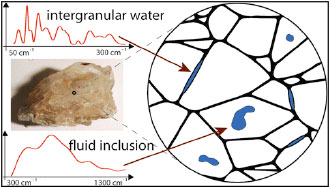
Figure 6. Researchers used inelastic neutron scattering to determine water environments in bedded salt
Homogenous salt formations provide a well-defined and predictable geologic barrier, but bedded salt formations (such as the Permian salt formations at WIPP) are typically heterogeneous and contain hydrous minerals. These minerals provide brine mobility paths through which waste might travel. Therefore, understanding water content and transport behavior in bedded salt formations is essential for determining suitability for storage of HGNW. Robust characterization of moisture content and its release in bedded rock salt is one of the key focus areas for HGNW storage in salt deposits. The authors used incoherent inelastic neutron scattering (IINS), an energy loss vibrational neutron spectroscopic method, to examine water environments in bedded salt. IINS is selectively sensitive to the dynamics of hydrogen atoms, is nondestructive, and easily penetrates large samples. The results demonstrate first-of-its-kind water signatures and their thermal stability in bedded salt.
Water in salt and its crucial role in deformation and weakening of rock salt during long-term creep have been recognized and studied extensively. Water occurs in rock salt in three forms: bound water in hydrous minerals (e.g., clays, hydrated salts), intergranular pore water at grain boundaries, and free water trapped as brine in fluid inclusions. The paper highlights two major problems impeding progress in determining water content and the study of its transport behavior in rock salt: 1) lack of an experimental technique to distinguish and quantify the three different water forms, particularly intergranular water, and 2) intrusive sample preparation required by analytical techniques can cause moisture loss and changes in brine composition. Previous studies have not considered the effect of nanoscale pore water confined in grain boundaries as opposed to bulk water on the coupled thermal-mechanical behavior of intact and crushed salt.
The researchers presented IINS measurements of bedded salts to distinguish the three water environments. The sixteen spectral lines in the 0-1100 cm-1 multiphonon and librational domain provide unprecedented high resolution for a natural material. This pioneering study shows that IINS can discriminate two moisture environments in halite (sodium chloride, NaCl) due to a difference in response to heat treatment at 100 oC of the sample. The first one, with very narrow resonances, is indicative of individual water molecules vibrating cooperatively with lattice vibrational modes of halite on grain boundaries. Moderate sample heating does not affect them. The second one results from fluid motion in brines that becomes visible once the signal due to moisture release from swelling clay is eliminated. The ability to partition the 0.07 weight % moisture in pristine halite over these two environments makes it possible to identify the proper moisture moiety (i.e. functional group of a molecule) responsible for hydrolytic weakening of halite.
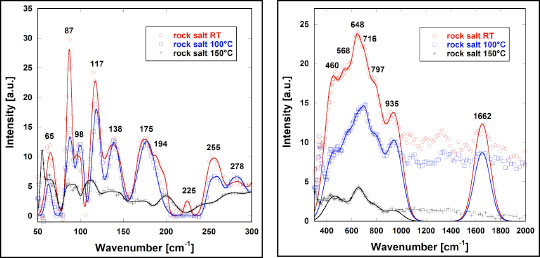
Figure 7. Three IINS spectra of rock salt in (a) multiphonon domain, (b) librational and a small segment of the vibration domain at room temperature (RT, red), dehydrated at 100 oC (blue), and at 150 oC (black). The dots represent the experimental data; the lines are fitted results using Gaussians. Disappearance of the 1662 cm-1 bending mode after treatment at 150 oC indicates the absence of water in the sample within the IINS detection limit.
The results shed light on a nearly 30-year old technical problem in characterizing different forms of water in rock salt. This pioneering study shows that IINS provides insight into the cause and effect of moisture migration and its coupling to thermomechanical properties in salt formations. The IINS spectral capability is a significant advance for thermomechanical studies of halite and more robust assessments of HNGW storage in bedded salt formations.
Reference: “Water Signatures and their Thermal Stability in Bedded Salt for Nuclear Waste Storage: An Incoherent Inelastic Neutron Spectroscopy Study,” Environmental Science & Technology Letters, 2, 308 (2015); doi: 10.1021/acs.estlett.5b00186. Authors: Mei Ding (Earth System Observations, EES-14), Erik Watkins (Materials Synthesis and Integrated Devices, MPA-11), Monika Hartl (European Spallation Source), and Luc Daemen (Oak Ridge National Laboratory).
The DOE, Office of Nuclear Energy, Used Fuel Disposition Campaign (UFD) program funded the research. IINS measurements were carried out at Lujan Neutron Scattering Center with the filter difference spectrometer (FDS), which the DOE Office of Science previously funded. The work supports the Lab’s Energy Security mission area and the Science of Signatures and Materials for the Future science pillars to provide a scientific analysis of proposed subsurface energy exploration and storage, including nuclear waste storage, in salts. Technical contact: Mei DingMaterials Science and Technology
Largest ever temperature range achieved while measuring TATB crystal structure
Laboratory researchers have measured the crystal structure of TATB (2,4,6-triamino-1,3,5- trinitrobenzene), an insensitive high explosive, from 30 K to 300 K—the largest ever temperature range for this material. This was also the first crystal structure investigation of TATB at 200 K and lower temperatures. The journal Propellants, Explosives, Pyrotechnics published the research.
TATB is a highly anisotropic molecular crystal used in several plastic-bonded explosive (PBX) formulations. It is a prime choice for applications where extreme safety is required because it is difficult to detonate by accident. However, TATB has an undesirable property. When a pellet of compacted TATB is heated and cooled a few times, anisotropic thermal expansion leads to a permanent change in shape and size of the bulk material, an effect called ratchet growth. This phenomenon could lead to part instability or material damage in some situations.
Researchers believe that the total temperature range of this thermal cycling is a primary driver for the total amount of growth. Measuring the effect of large temperature ranges on the TATB crystal structure could provide insight into the mechanisms that govern ratcheting behavior. A detailed understanding of the response of TATB to temperature changes is of great importance to mitigate or accommodate this behavior. A theoretical understanding of the relationship between anisotropy of the crystal, crystal orientation distribution (texture) of polycrystalline aggregates, and the intergranular interactions leading to this irreversible growth is necessary to develop physics-based predictive models for TATB-based PBXs under various thermal environments.
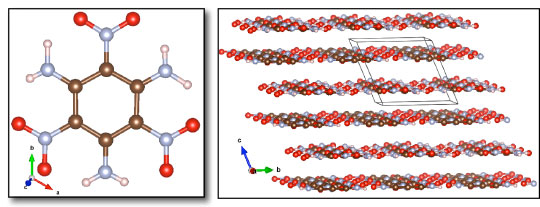
Figure 8. (Left): TATB molecule with carbon, nitrogen, oxygen, and hydrogen atoms in brown, silver, red, and pink, respectively. (Right): The TATB crystal structure depicts the graphite-like arrangement of the molecules. The thermal expansion between the planes along the crystallographic c-axis is about one order of magnitude greater than the expansion within the planes along the a and b axes.
Researchers used the high-pressure/preferred orientation (HIPPO) neutron diffractometer at the Los Alamos Neutron Science Center (LANSCE) to collect data for the lattice-parameter specific thermal expansion of TATB from 30 K to 300 K. Previous work covered the range from 200 K and above. Changes in the TATB crystal structure or the orientation of the TATB crystals, or texture, have not previously been measured in situ during ratchet growth. HIPPO provides the unique opportunity to collect this type of data. The team also collected data to characterize the texture of the crystals to determine if measurable grain reorientation leads to the ratchet growth. The investigators used the experimental data to constrain and improve models simulating the material properties, such as microstructure, as a function of temperature.
The research will aid in benchmarking and improving modeling efforts that incorporate how TATB responds to temperature fluctuations. Experiments exploring the crystal structure above room temperature extended the range over which the thermal expansion of each lattice parameter is available. To investigate the role of the binder in the PBX 9502 high explosive formulation, data, the team also collected data with that material in addition to the “neat” (i.e., without binder) polycrystalline TATB. Analysis of the neutron diffraction data is ongoing.
Reference: “Neutron Diffraction Measurements and Micromechanical Modelling of Temperature-Dependent Variations in TATB Lattice Parameters,” Propellants, Explosives, Pyrotechnics (2016), doi:10.1002/prep.201500286. Authors: John D. Yeager (Shock and Detonation Physics, M-9), Darby J. Luscher (Fluid Dynamics and Solid Mechanics, T-3), Sven C. Vogel, Bjorn Clausen, and Donald W. Brown (Materials Science in Radiation and Dynamics Extremes (MST-8).
The work is an example of science on the roadmap to MaRIE, the Laboratory’s proposed experimental facility for control of time-dependent material performance. MaRIE’s combination of x-ray and neutron scattering methods would provide unprecedented, time-resolved access to structural properties of materials from atomic- to meso-scales.
The B61 Life Extension Program and NNSA Science Campaign 1: Primary Assessment Technologies funded the work, which supports the Laboratory’s Nuclear Deterrence mission area and Materials for the Future and Science of Signatures science pillars. Technical contact: Sven VogelPhysics
Los Alamos aids in MicroBooNE’s first neutrino sightings
The MicroBooNE neutrino detector made its first observation of neutrinos – building blocks of matter that are difficult to study because they have no electrical charge. Los Alamos expertise in target fabrication, accelerator beamline operations, and data acquisition systems has been important for the newly commissioned, multi-laboratory experiment at Fermi National Accelerator Laboratory.
MicroBooNE’s purpose is to confirm or deny the existence of a hypothetical particle known as the sterile neutrino. Three types of neutrinos have been detected, and the detection of a fourth type would be a major contribution to modern particle physics. MicroBooNE will search for sterile neutrinos by measuring how neutrinos mix and change from one type into another, a process called neutrino oscillations that occurs because neutrinos have mass.
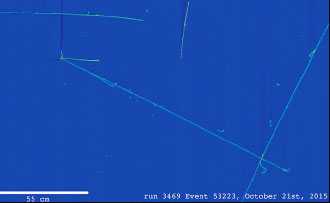
Figure 9. An accelerator-born neutrino candidate, spotted with the MicroBooNE detector. Image credit: Fermilab.
MicroBooNE will measure low energy neutrino cross sections and investigate the low energy excess events observed by the MiniBooNE experiment. The detector also serves as a next step in a phased program towards the construction of massive kiloton scale detectors for future long-baseline neutrino physics (Deep Underground Neutrino Experiment, DUNE), and it is the first detector in the short-baseline neutrino program at Fermilab.
The MicroBoone time projection chamber is filled with 170 tons of liquid argon. It resembles a silo lying on its side. Because liquid argon is 40 percent denser than water, neutrinos are more likely to interact with it. When an accelerator-born neutrino hits the nucleus of an argon atom in the detector, its collision creates a spray of subatomic particle debris. Tracking these particles allows scientists to determine the type and properties of the neutrino that produced them.
The Booster Neutrino Beamline, part of the Accelerator Complex at Fermilab, produces protons with energies as high as 8 GeV. These protons impinge on a beryllium target and produce a secondary beam of pions that decay into muons and neutrinos. MicroBooNE detects these neutrinos. MicroBooNE started receiving its very first neutrino beam from the Fermilab Booster accelerator on October 15, 2015. On November 2, 2015, the team released the first neutrino event candidates that the automated neutrino event reconstruction identified.
MicroBooNE can test the combined evidence for neutrino oscillations from the Liquid Scintillator Neutrino Detector (LSND) at Los Alamos and the related MiniBooNE project at Fermilab by determining whether there is an excess of energetic electron events, as expected for oscillations, or an excess of energetic photon events, which would indicate some other process. With the MicroBooNE liquid argon time projection chamber, events with an energetic electron can be distinguished from energetic photon events.
Geoff Mills and Gerald Garvey (Subatomic Physics, P-25) were responsible for the construction of the Booster Neutrino Beamline beryllium target. They worked closely with Fermilab staff and Richard Van de Water (P-25) to monitor and debug elements of the beamline during its 10 years of running for MiniBooNE, a related Fermilab project. Former LANL scientists Wesley Ketchum and Zarko Pavlovic (now at Fermilab) contributed to the beamline and the data acquisition system. The DOE Office of Science funds LANL’s work. Mills also led the HARP-MiniBooNE collaboration, which produced well-measured pion yields that improved neutrino flux estimates for the MicroBooNE beamline. The team used these flux calculations to develop preliminary oscillation and cross section analyses. A Laboratory Directed Research and Development (LDRD)-funded project supported LANL’s HARP-MiniBooNE work.
The research supports the Lab’s Nuclear and Particle Futures science pillar. It is an example of physics beyond the standard model research to understand the deeper theory of the fundamental forces that define the universe. Technical contacts: Bill Louis and Richard Van de Water
Theoretical
Climate sensitivity of the glaciers of the McMurdo Dry Valleys in Antarctica
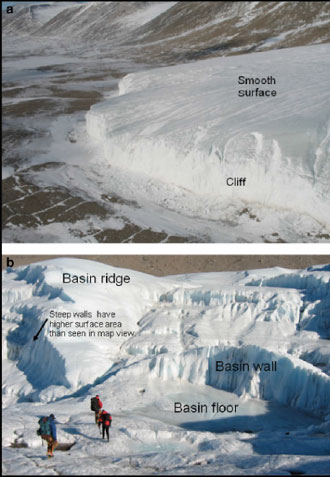
Photos. Topographic morphologies modeled. (a) Smooth surface and cliff topographic morphologies (Howard Glacier). The cliff here is approximately 25 m high. (b) Basin morphology showing floors, walls and ridges (Taylor Glacier).
The McMurdo Dry Valleys of Antarctica host the coldest and driest ecosystem on Earth. This polar desert is acutely sensitive to the availability of water coming from glacial runoff. Snowfall is infrequent, and most snow sublimates with relatively little melt to the soils and streams. Glacier surfaces are typically below the melt threshold during the summer, and runoff is quite limited given the large expanse of ice present in the valleys. There has been little research on the climate sensitivity of these glaciers and polar glaciers in general. A research team, including Matthew Hoffman (Fluid Dynamics and Solid Mechanics, T-3), has modeled the spatial variability in ablation (ice melt and sublimation) and assessed climate sensitivity of the glaciers using 16 years of meteorological and surface mass balance (the net mass gain or loss of ice on the surface of the glacier) data and observations collected in Taylor Valley. The researchers considered changes to air temperature, ice albedo and wind speed in their assessment. The Journal of Glaciology published their findings.
The research team used a model that they had developed previously to describe a surface energy-balance model that works well for the glaciers of the McMurdo Dry Valleys. The model reproduces observations of surface lowering, ice temperature and ice density when penetration of solar radiation into the ice is included and when subsurface meltwater is allowed to drain
away. The investigators applied the model across the ablation zones of the glaciers of Taylor Valley to determine whether the previous results and processes explain valley-wide mass-balance observations over 15 summers. After validating the model across the valley, the team used it to investigate a change in ablation sensitivity that occurred midway through the period of study. They also assessed climate sensitivity of the glaciers, considering changes to air temperature, ice albedo, and wind speed.
The new findings showed that sublimation was the primary form of mass loss over much of the glaciers, except for near their termini where melt, primarily below the ice surface in an ice weathering crust, dominated. Microclimates in rough approximately 10 m scale topographic basins generated melt rates up to ten times higher than over smooth glacier surfaces. In contrast, the vertical terminal cliffs of the glaciers can have higher or lower melt rates than the horizontal surfaces due to differences in incoming solar radiation associated with aspect. Surface mass balance sensitivity to changes in temperature was about -0.02 m w.e. (water equivalent) K‐1, which may be the smallest magnitude observed globally. The authors attribute this low sensitivity to the cold climate such that most of the energy received at the glacier surface goes to warming the ice up to the melting point each spring or is lost to the atmosphere through sublimation. The sensitivity increases as the climate is increasingly warmed in the model simulations, and melting becomes more frequent. The researchers also identified a high sensitivity to ice albedo. An albedo decrease of 0.02 has similar effects to a 1 K increase in temperature. This result suggests that modest changes in dust deposition could have a far larger effect on melting of these glaciers than the temperature change expected from future climate change for this region.
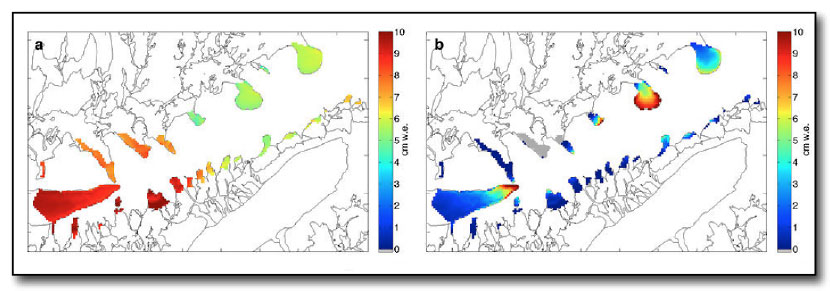
Figure 10. Map of modeled summer melt rates across all of the glaciers in Taylor Valley. (a) Sublimation on smooth surfaces. (b) Melt on smooth surfaces. Melt includes both surface melt and drainage of subsurface melt.
Reference: “Distributed Modeling of Ablation (1996–2011) and Climate Sensitivity on the Glaciers of Taylor Valley, Antarctica,” Journal of Glaciology / FirstView Article / April 2016, pp 1 – 15, doi: 10.1017/jog.2015.2, Published online: 24 February 2016. Authors: Matthew J. Hoffman (Fluid Dynamics and Solid Mechanics, T-3), Andrew G. Fountain (Portland State University), and Glen E. Liston (Colorado State University).
DOE climate modeling program in the Office of Science funded the LANL research, which supports the Lab’s Global and Energy Security mission areas and the Information, Science, and Technology science pillar through modeling the climate sensitivity of polar glaciers. Technical contact: Matthew Hoffman








